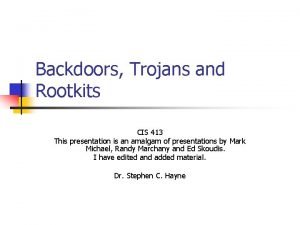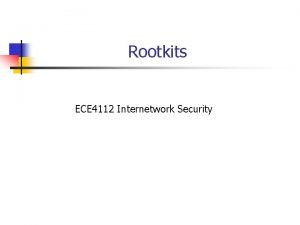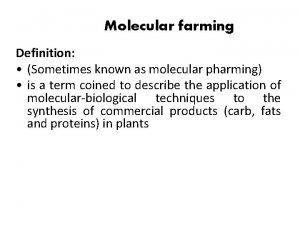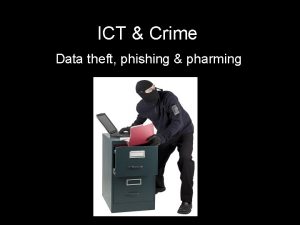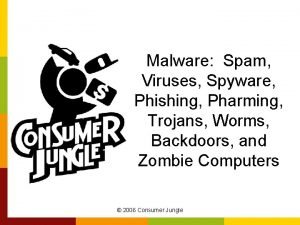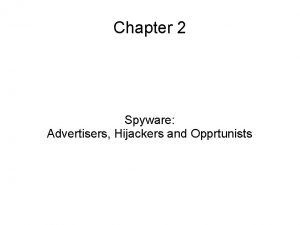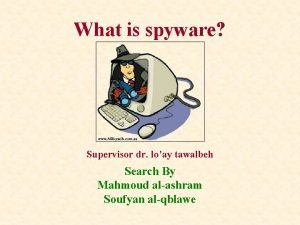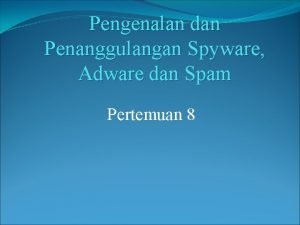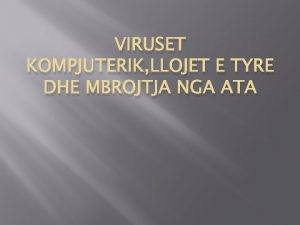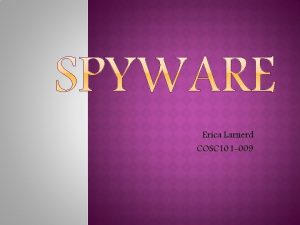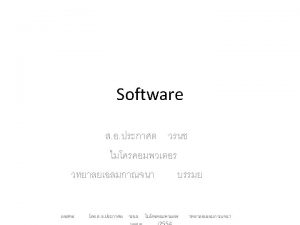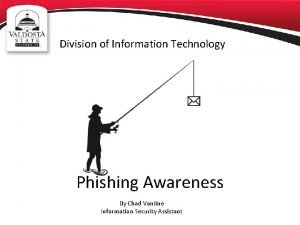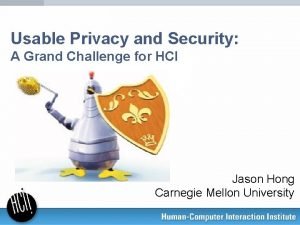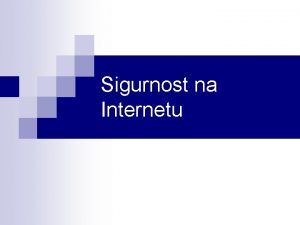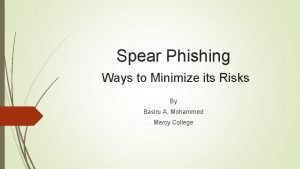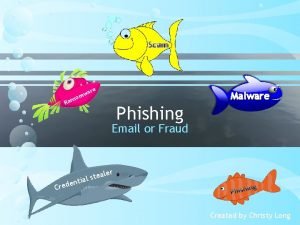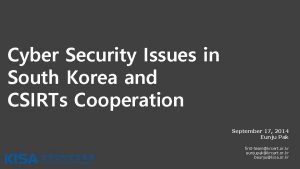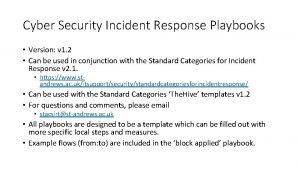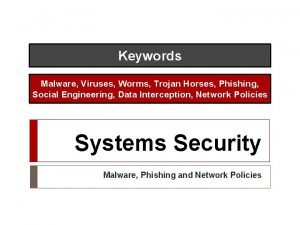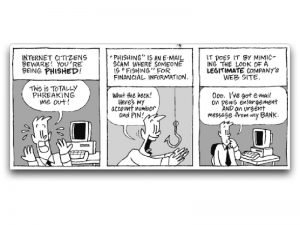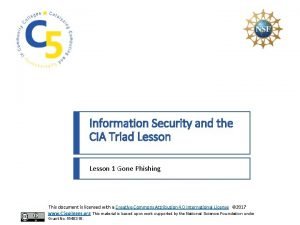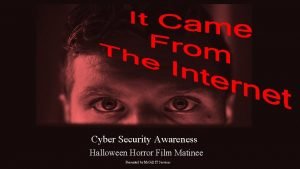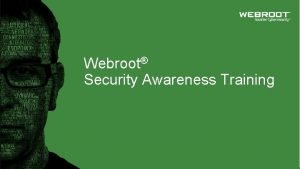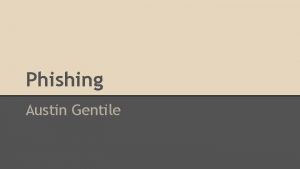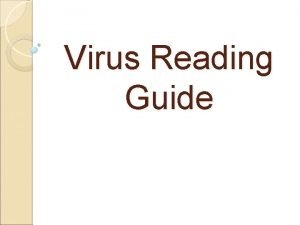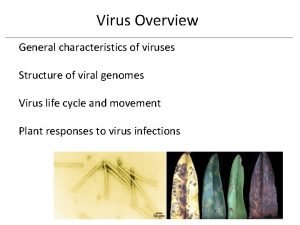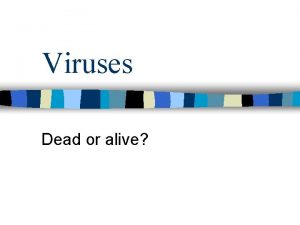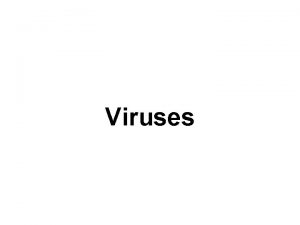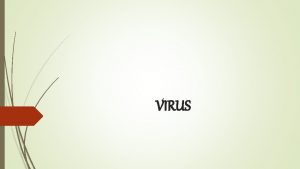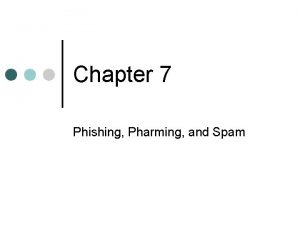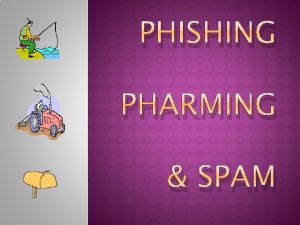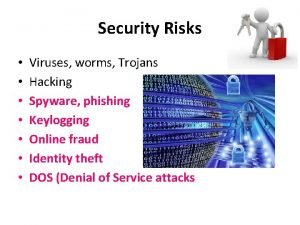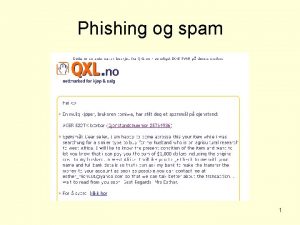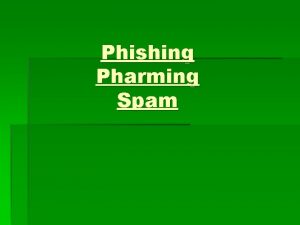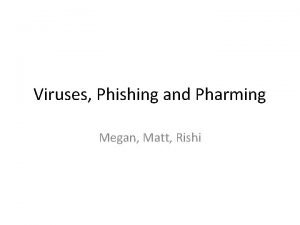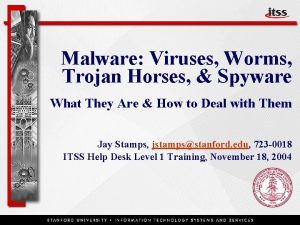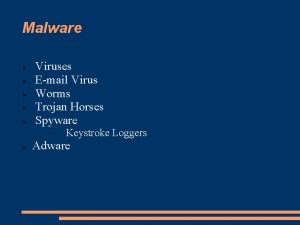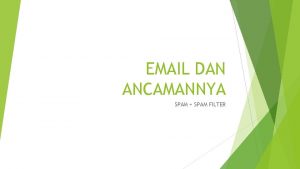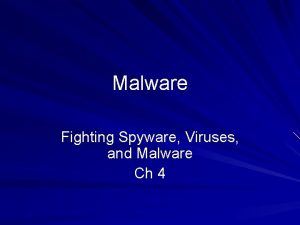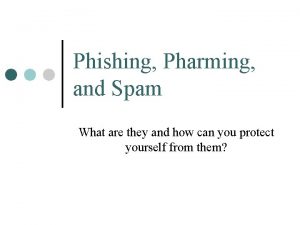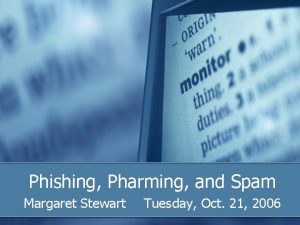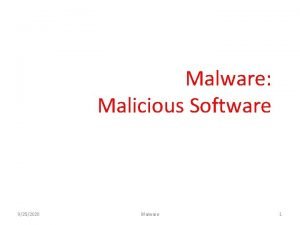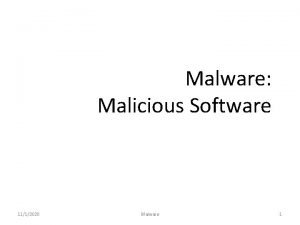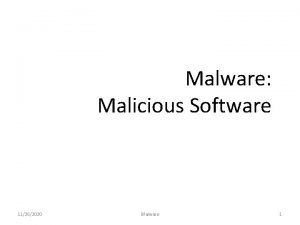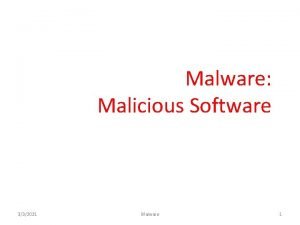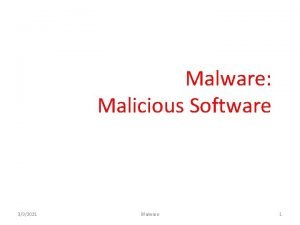Malware Spam Viruses Spyware Phishing Pharming Trojans Worms











































- Slides: 43

Malware: Spam, Viruses, Spyware, Phishing, Pharming, Trojans, Worms, Backdoors, and Zombie Computers © 2006 Consumer Jungle

Estimating the Threat of Malware • 1 -in-3 chance of suffering: – computer damage – financial loss • Viruses & Spyware © 2006 Consumer Jungle – $2. 6 Billion to Protect yet $9 Billion to Replace

Spam © 2006 Consumer Jungle

What is Spam? • An e-mail that is: – Unsolicited – Advertising something • Similar to: – Junk mail delivered in the mail – Telemarketing calls on the phone © 2006 Consumer Jungle

CAN SPAM Act of 2003 • Acronym stands for: – Controlling the Assault of Non. Solicited Pornography And Marketing • Allows spam as long as it contains: – an opt-out mechanism – a valid subject line and header (routing) information – the legitimate physical address of the mailer – a label if the content is for adults only • Regulated by the FTC, but has made little impact to curb Spam. © 2006 Consumer Jungle

Virus © 2006 Consumer Jungle

What is a Virus? • A program that can replicate itself and spreads itself by means of a transferable host. • How a virus spreads: – Removable Medium – Network Connection © 2006 Consumer Jungle

Why is it Called a Virus? • Similar to a biological virus that spreads itself into living cells. – Insertion of a virus is called an infection – Infected file is called a host. © 2006 Consumer Jungle

Virus Tricks: What to Look For © 2006 Consumer Jungle

The Infected Document • Subject line includes the name of the sender – Probably someone you know • Message tempts you to open attachment • Attachment is a legitimate Word file that is infected with a macro © 2006 Consumer Jungle

The Misleading File Name • Look at the attachment's name "LOVE-LETTER-FOR-YOU. TXT. vbs – Looks like a harmless text (TXT) file, but it is a vbs file with a windows script – The suffix (. vbs) might be completely hidden – appearing to be a type of file you’d willingly open i. e. JPEG, MP 3, or PDF. © 2006 Consumer Jungle

The Offer You Can’t Refuse • Gives a compelling message – get rid of a computer virus • Doesn’t disguise that the attachment is a program • The program is a worm that sends itself to e-mail addresses it finds on your computer © 2006 Consumer Jungle

The Fake Web Link • Subject and message suggest that opening attachment will take you to a web page containing party photos. • Attachments name resembles a web address – Actually a program that sends itself to people in your address book • Designed to tie up your e-mail; can also be designed to destroy data © 2006 Consumer Jungle

Spyware © 2006 Consumer Jungle

What is Spyware? • Malicious software that – Subverts the computer’s operation for the benefit of a third party • Designed to exploit infected computers for commercial gain via: – Unsolicited pop-up advertisements – Theft of personal information – Monitoring of web-browsing for marketing purposes – Re-routing of http requests to advertising sites © 2006 Consumer Jungle

Example of Spyware • According to an October 2004 study by America Online and the National Cyber-Security Alliance: – 80% of surveyed users had some form of spyware on their computer. © 2006 Consumer Jungle

Phishing © 2006 Consumer Jungle

What is Phishing? • An attempt to fraudulently acquire confidential information, such as: – passwords – credit card details • By masquerading as a trustworthy: – – – • Business Financial Institution Government Agency Internet Service Provider Online Payment Service Person In an apparently official electronic communication, such as: – an email – an instant message. © 2006 Consumer Jungle

Why is it called Phishing? • Hackers coined the phrase – “Fish” for accounts – Ph is a common hacker replacement for the letter “f”. © 2006 Consumer Jungle

How does Phishing Work? • E-mail contains a link to a “look alike” website. • Website asks the consumer to : – – Confirm Re-enter Validate (or) Verify Their personal info, i. e. – – Social Security Number Bank Account Number Credit Card Number Password © 2006 Consumer Jungle

Pay. Pal Phishing • Look for spelling mistakes: – Choise – Temporaly • Presence of an IP address in the link visible under the yellow box ("Click here to verify your account") © 2006 Consumer Jungle

Phishing for e. Bay Customers • Phishing e-mails from e. Bay’s online payment company Pay. Pal is very popular. • However, e. Bay no longer sends out e-mails. – They created an online email account for customers to receive e-mails after they’ve logged into the secure website. © 2006 Consumer Jungle

Advanced Phishing Techniques • Instead of sending an emails persuading consumers to visit websites, the e-mail deploys a key-logging Trojan. • As soon as the user visits their bank’s website all the typed keys are logged and sent back to the hacker with the account number, passwords, and other critical data. © 2006 Consumer Jungle

How to Avoid Phishing • Be skeptical • Ignore the “dire consequences” warning. • Don’t reply • Don’t click on the link – Contact the company directly via a: • Legitimate 1 -800 telephone number • Website • Look at the “address bar” – Often a different domain name © 2006 Consumer Jungle

More Tips on Avoiding Phishing • Don’t e-mail personal or financial information. • Open a new browser and look for secure indicators: – Secure lock – https: (s stands for secure) © 2006 Consumer Jungle

What to do with Phishing E-mails • Forward to spam@uce. gov and cc the group that the e-mail impersonates. • Mark as “Junk Mail” in your Spam Software • Delete immediately • File a complaint with the Federal Trade Commission (FTC) – www. ftc. gov – 1 -877 -FTC-HELP (1 -877 -382 -4357) © 2006 Consumer Jungle

Pharming © 2006 Consumer Jungle

What is Pharming? • Exploitation of a vulnerability in the hosts’ file or DNS server software that allows a hacker to: – Acquire the domain name for a site – Redirect that website’s traffic to another website • For gaining access to usernames, passwords, etc. © 2006 Consumer Jungle

Pharming Techniques • The criminal uses a virus or Trojan to modify a user’s ‘Hosts’ file. – OR • The criminal sends out a spam for www. phishsite. com, and the message links to an illegitimate site. – AND • When the user opens the browser and enters the website address, they get sent to the phishing site instead. © 2006 Consumer Jungle

Trojans © 2006 Consumer Jungle

What is a Trojan? • A malicious program that is disguised as a legitimate program. • Usually has a useful function that camouflages undesired functions. • Can not replicate or spread itself. © 2006 Consumer Jungle

Why is it Called a Trojan? • Derived from myth. – Greeks left large wooden horse outside the city of Troy. – Trojans thought it was a gift and moved the horse inside the city wall. – The horse was hollow and filled with Greek soldiers. – Greek soldiers opened the city gates at night for the remaining army to attack. • Application: Greeks gained malicious access to the city of Troy just like a Trojan program gains malicious access to your computer. © 2006 Consumer Jungle

Example of a Trojan • Program posted on a website: – Called FREEMP 3. EXE – Promise “free mp 3 files” • Instead, when run: – Erases all the files on your computer – Displays a taunting message © 2006 Consumer Jungle

What Can a Trojan Do? • • Erase or overwrite data on a computer Corrupt files in a subtle way Spread other malware, such as viruses. In this case the Trojan horse is called a 'dropper'. Set up networks of zombie computers in order to launch “Denial of Service” attacks or send out spam. Spy on the user of a computer and covertly reports data like browsing habits to other people. Log keystrokes to steal information such as passwords and credit card numbers. Phish for bank or other account details. © 2006 Consumer Jungle Install a backdoor on a computer system.

Where Do Trojans Come From? • Infected Programs • Websites • Email • Direct Connection to the Internet © 2006 Consumer Jungle

Worms © 2006 Consumer Jungle

What is a Worm? • Computer program – self-replicating – self-contained • Designed to exploit: the file transmission capabilities on your computer © 2006 Consumer Jungle

Why is it Called a Worm? • Word taken from a 1970’s science fiction novel: – The Shockwave Rider • By John Brunner • Researchers found that their selfreplicating program was similar to the worm program described in the book. © 2006 Consumer Jungle

What Can a Worm Do? • Delete files on a host system • Send documents via e -mail • Create excessive network traffic • Install a backdoor © 2006 Consumer Jungle

What is a Backdoor? • Method of remaining hidden on a computer while: – bypassing normal authentication – Securing remote access to a computer • Can be installed by a worm © 2006 Consumer Jungle

What is a Zombie Computer? • Computer attached to the internet that: – Is under remote direction of an illegitimate user • Check your computer – www. ordb. org © 2006 Consumer Jungle

Zombie Computers & Spam • Used to send e-mail spam – 50% to 80% of all spam worldwide is now sent by zombie computers. • Allows spammers to: – Avoid detection – Have zombie computers pay for their bandwidth. © 2006 Consumer Jungle

Suspicion = Prevention • Best prevention is awareness • Be suspicious of everything to avoid: – – – – Spam Viruses Spyware Phishing Pharming Trojans Worms Backdoors © 2006 Consumer Jungle
 Trojan horses spyware and worms are all forms of
Trojan horses spyware and worms are all forms of Https://m..com/watch?v=nqecciuc7jy
Https://m..com/watch?v=nqecciuc7jy Youtube
Youtube Cuckoo sandbox vm
Cuckoo sandbox vm A trusted officer of odysseus
A trusted officer of odysseus Lkm trojan
Lkm trojan Beware of backdoor trojans
Beware of backdoor trojans Trojan workout
Trojan workout Lrk v4 trojans
Lrk v4 trojans Why is pharming controversial
Why is pharming controversial Molecular pharming definition
Molecular pharming definition Gene pharming
Gene pharming Pharming ict
Pharming ict Pharming biologia
Pharming biologia Example of spyware
Example of spyware Periwinkle doerfler
Periwinkle doerfler 2 spyware
2 spyware Spyware dr
Spyware dr Spyware adalah
Spyware adalah Viruset kompjuterike dhe llojet e tyre
Viruset kompjuterike dhe llojet e tyre Anti spyware 101
Anti spyware 101 Spyware
Spyware Types of phishing attacks
Types of phishing attacks Anti phishing phil
Anti phishing phil Phishing primjeri
Phishing primjeri Super phisher
Super phisher Mobi fish
Mobi fish Setoolkit
Setoolkit Phishing
Phishing Ics phishing sms
Ics phishing sms Cyber security playbooks
Cyber security playbooks Phishing
Phishing Email phishing
Email phishing Howsecureismypassword phishing
Howsecureismypassword phishing Phishing cia triad
Phishing cia triad Halloween phishing
Halloween phishing Webroot cyber security training
Webroot cyber security training Phishing austin texas
Phishing austin texas What are viruses lesson 3
What are viruses lesson 3 How active viruses multiply
How active viruses multiply Which of the following is plant virus
Which of the following is plant virus Are viruses dead or alive
Are viruses dead or alive How do viruses differ from living things
How do viruses differ from living things General characters of viruses
General characters of viruses






